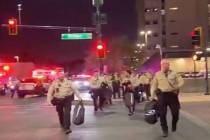Complaints point out waste
The budgetary scalpel is cutting perilously close to the Clark County School District's muscle and bone, education leaders say.
As he braces to cut expenses to meet next year's anticipated $150 million budget deficit, frustrated Superintendent Walt Rulffes is telling the public to "show me where to cut."
District leaders have spent months identifying ways to lessen the pain of reduced state funding in hard economic times, but critics ranging from parents to district insiders maintain that student-related programs can be saved with reductions in other areas.
A review of the district budget, more specifically salaries from 2007-08, found the most common complaints, excessive overtime and costly administration, reflected expenditures found on the books.
In the past two school years, the district spent $26 million on employee overtime, with police officers doubling their salaries and a secretary earning more than $90,000. It's also paying for a union-negotiated task force on teacher morale staffed with union activists, which costs more than $200,000 in salaries annually.
The district also funds two separate entities to seek charitable contributions. In some cases, both take credit for the same donations.
Kevinn Donovan, a Henderson father, is among those who think there's still budget fat in the district that has to go.
"You have a massive school district with sub-administrations," Donovan said. "I would love to get in there and really clean house."
Martin Dupalo, an adjunct professor of political science at the University of Nevada, Las Vegas, said the school system could be more efficient and more responsive to the public if it deconsolidated into five or six independent districts, but he doubts that special interest groups, such as employee unions, would support that since it could erode their power.
Here's a closer look at the most frequent criticisms of school district spending:
EMPLOYEE OVERTIME
Because of overtime, two school police officers, Anthony Cooke and Christopher Law, were paid $160,640 and $180,261 last year, well over their base salaries of $54,326 and $67,409, respectively. They were the district's top earners and made more last year than any other employee except for Rulffes, whose own secretary, Elizabeth Carrero, was paid an additional $21,086 in overtime for a total salary of $90,507.
The district has recognized that overtime has gotten excessive and has instituted reforms such as making supervisors approve all overtime requests in advance. It's also looking for ways to lessen the demands on police officers, who must cover athletic events and after-school activities.
Phil Gervasi, former president of the school police officers union, said the amount of overtime shows the district is understaffed. The district as a whole is benefiting because it's getting by with fewer employees.
"In the long run, overtime benefits the employer, not the employee," said Gervasi, who now is executive officer of the Nevada division of the California Organization of Police and Sheriffs.
Teachers are ineligible for overtime as salaried employees, but it is not impossible for teachers to make six-figure incomes, even though the top pay scale for teachers is $70,060.
Three classroom teachers and one school librarian made between $101,000 and $116,000 last year. Human resources officials said teachers can supplement their salaries by taking on extra duties such as coaching or supervising extracurricular activities, conducting professional training and teaching extra classes.
Ruben Murillo, president of the Clark County Education Association, said high-paid teachers are working the equivalent of two full-time jobs since they're typically working long hours at night.
"I'm glad teachers can make that much money," he said. "I wish everybody could."
DUPLICATE FUNDRAISING
Functions of the Public Education Foundation and the School Community Partnership Program are so intertwined that both can share credit for raising the same $1.1 million in 2007, said Michael Rodriguez, a district spokesman.
The Public Education Foundation is organized independently of the district. The district contributes $649,891 to the foundation's budget and pays for seven employee salaries, or about 20 percent of its budget. In return, the foundation raised about $4.3 million in 2007 in donations for the district. That includes the $1.1 million also credited to the district's partnership office.
Sig Rogich, chairman of the foundation, said the school district's return on investment is "7-to-1."
The School Community Partnership, which does not solicit cash donations, does work with businesses and organizations that come forward with volunteers and in-kind services. Last year the partnership, which has a budget of $1.1 million, assisted with raising $14.4 million in gifts or in-kind services.
Rulffes said it more "than paid for itself."
As an example of an in-kind service, the Las Vegas Mini Gran Prix on North Rainbow Boulevard near Vegas Drive gives certificates to schools so teachers and principals can reward students with free parties at the race track. The partnership's employee recognition officer also distributes freebies such as donated tickets to shows on the Strip and restaurant gift certificates.
TEACHING AND LEARNING CONDITIONS
In other districts, an employee recognition officer and a morale task force might fall "under the same umbrella," acknowledged spokesman Rodriguez.
But the Teaching and Learning Conditions team, created in 2006, is part of a "good faith" agreement between the district and the Clark County Education Association, which represents teachers.
According to the union contract reached with the district, it is in the interest of both the union and the district to create better working conditions and reduce employee turnover.
In addition to $276,528 for salaries, the district spends up to $150,000 for an outside survey each year on teacher morale. The morale team follows up on the survey's findings and conducts focus groups and training at the school level.
At least three of the four jobs this year have gone to active union members, including past union president Mary Ella Holloway, newly elected union board member Cindy Johnson and Victoria Courtney, who took a union-paid leave of absence from the committee last year to campaign for School Board candidates.
Murillo said the four jobs on the team are not used to reward union activism, since the district fills the positions. Karyn Wright, a district human resource official, denied that union ties played a factor in hiring.
Because of hard economic times, Murillo acknowledged the district could scrap the team. "Nothing's guaranteed," he said.
CUTS ARE BEING MADE
District administrators said they are very responsive to the public's demands to reduce bureaucratic waste. They note that the central administration's budget is being cut by 12 percent. Administrative positions are being left open. The supervisor-to-employee ratio has risen to 35-to-1.
But district officials may never be able to satisfy critics. As New York Times columnist Gail Collins recently pointed out, "The waste argument is a perpetual winner, because there's always going to be some."
Contact reporter James Haug at jhaug @reviewjournal.com or 702-374-7917.












